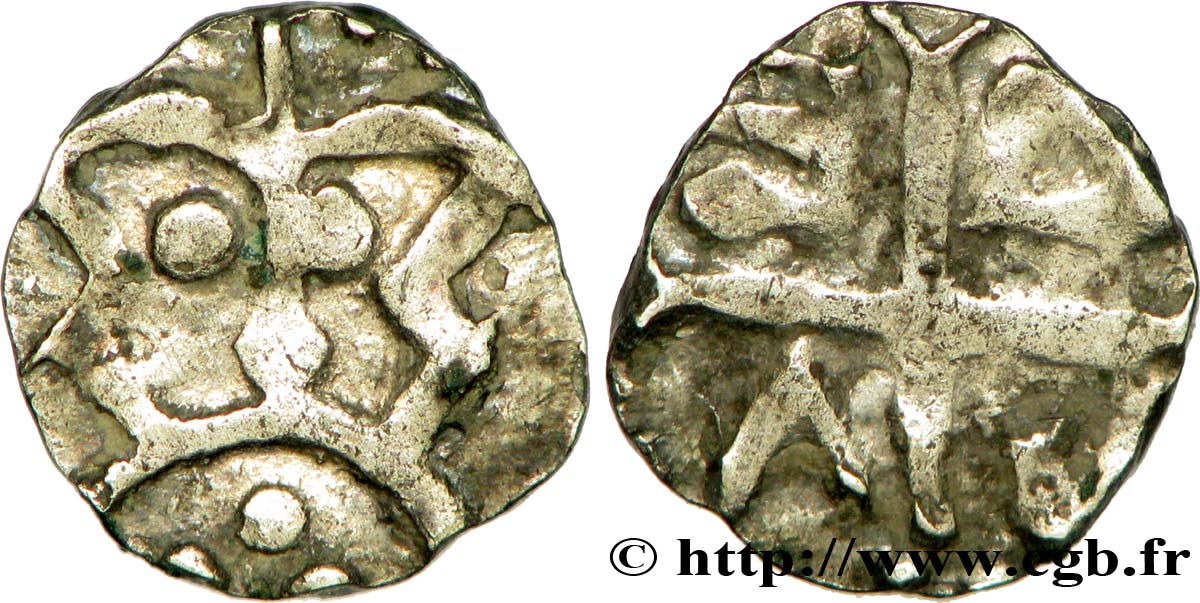v38_1687 - MEROVINGIAN COINAGE - BANASSAC (BANNACIACO) - Lozere Denier
MONNAIES 38 (2009)
Starting price : 350.00 €
Estimate : 500.00 €
Realised price : 410.00 €
Number of bids : 4
Maximum bid : 560.00 €
Starting price : 350.00 €
Estimate : 500.00 €
Realised price : 410.00 €
Number of bids : 4
Maximum bid : 560.00 €
Type : Denier
Date: (VII-VIIIe siècles)
Mint name / Town : Banassac
Metal : silver
Diameter : 12 mm
Orientation dies : 12 h.
Weight : 1,43 g.
Rarity : R3
Coments on the condition:
Denier sur un flan épais et régulier, presque rond, de poids particulièrement lourd ! Frappe centrée et vigoureuse des deux côtés. Patine grise plus ou moins homogène avec de petites concrétions de surface
Catalogue references :
Obverse
Obverse description : Calice à deux anses ou mitre stylisée (?), surmonté d’une croisette et surmontant trois annelets posés en triangle.
Reverse
Reverse legend : E - D - A - Z.
Reverse description : Croix aux bras bifides, une lettre dans chaque canton.
Commentary
Le calice, typique du monnayage d’argent de Banassac, est différent sur ce denier par rapport à ceux du Belfort, par exemple. Pour ce type, toutes variétés confondues, G. Depeyot n’a répertorié que neuf exemplaires ; les trois du Belfort, trois de la vente Cahn 1932, deux du trésor de Saint-Pierre-les Etieux et un du trésor de Bais. Un dixième exemplaire est aussi classé à Banassac à cause du calice, mais d’un tout autre type (cf. B. 5757).
Au revers, les lettres A et Z sont relativement nettes dans les 3e et 4e cantons de la croix, mais les lettres dans les deux premiers cantons sont difficiles à identifier. D’après les monnaies n° 774 à 777 du Belfort, il devrait s’agir de RA-G ou LA. Les lettres RAG ont fait attribuer ces deniers à Ragenfrid, mais A. de Belfort les restitue à Banassac en raison des analogies avec les monnaies d’or au calice.
Seulement sur l’exemplaire proposé ici, l’analogie n’est pas du tout évidente et les lettres semblent plutôt être E (rétrograde) au premier canton et D au deuxième canton !
Bien qu’aucune autre monnaie d’argent s’en approchant ne semble être publiée, il est permis de douter de la parenté de ce denier avec les monnaies traditionnellement attribuées à Banassac ?.
The chalice, typical of the silver coinage of Banassac, is different on this denarius compared to those of Belfort, for example.. For this type, all varieties combined, G. Depeyot only listed nine examples; the three from Belfort, three from the 1932 Cahn sale, two from the Saint-Pierre-les-Etieux treasure and one from the Bais treasure.. A tenth example is also classified in Banassac because of the chalice, but of a completely different type (cf.. B. 5757).
On the reverse, the letters A and Z are relatively clear in the 3rd and 4th cantons of the cross, but the letters in the first two cantons are difficult to identify. According to coins no. 774 to 777 from Belfort, it should be RA-G or LA. The letters RAG have attributed these coins to Ragenfrid, but A. Belfort returned them to Banassac because of the similarities with the gold coins with the chalice.
Only on the example proposed here, the analogy is not at all obvious and the letters seem rather to be E (retrograde) in the first canton and D in the second canton! Although no other silver coin approaching it seems to be published, it is permissible to doubt the relationship of this denier with the coins traditionally attributed to Banassac?
Au revers, les lettres A et Z sont relativement nettes dans les 3e et 4e cantons de la croix, mais les lettres dans les deux premiers cantons sont difficiles à identifier. D’après les monnaies n° 774 à 777 du Belfort, il devrait s’agir de RA-G ou LA. Les lettres RAG ont fait attribuer ces deniers à Ragenfrid, mais A. de Belfort les restitue à Banassac en raison des analogies avec les monnaies d’or au calice.
Seulement sur l’exemplaire proposé ici, l’analogie n’est pas du tout évidente et les lettres semblent plutôt être E (rétrograde) au premier canton et D au deuxième canton !
Bien qu’aucune autre monnaie d’argent s’en approchant ne semble être publiée, il est permis de douter de la parenté de ce denier avec les monnaies traditionnellement attribuées à Banassac ?.
The chalice, typical of the silver coinage of Banassac, is different on this denarius compared to those of Belfort, for example.. For this type, all varieties combined, G. Depeyot only listed nine examples; the three from Belfort, three from the 1932 Cahn sale, two from the Saint-Pierre-les-Etieux treasure and one from the Bais treasure.. A tenth example is also classified in Banassac because of the chalice, but of a completely different type (cf.. B. 5757).
On the reverse, the letters A and Z are relatively clear in the 3rd and 4th cantons of the cross, but the letters in the first two cantons are difficult to identify. According to coins no. 774 to 777 from Belfort, it should be RA-G or LA. The letters RAG have attributed these coins to Ragenfrid, but A. Belfort returned them to Banassac because of the similarities with the gold coins with the chalice.
Only on the example proposed here, the analogy is not at all obvious and the letters seem rather to be E (retrograde) in the first canton and D in the second canton! Although no other silver coin approaching it seems to be published, it is permissible to doubt the relationship of this denier with the coins traditionally attributed to Banassac?








 Report a mistake
Report a mistake Print the page
Print the page Share my selection
Share my selection Ask a question
Ask a question Consign / sell
Consign / sell
 Full data
Full data












